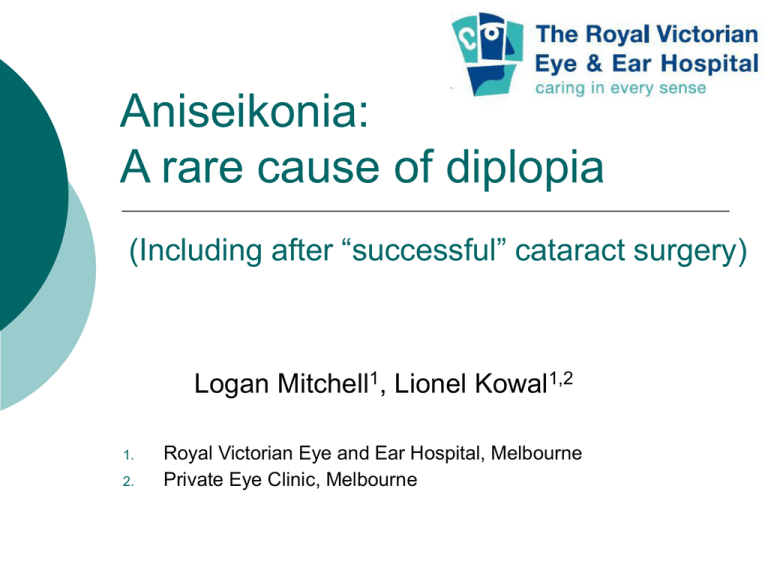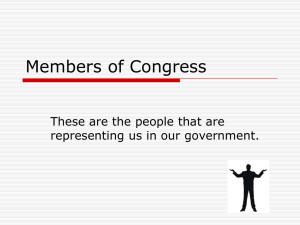
Aniseikonia:
A rare cause of diplopia
(Including after “successful” cataract surgery)
Logan Mitchell1, Lionel Kowal1,2
1.
2.
Royal Victorian Eye and Ear Hospital, Melbourne
Private Eye Clinic, Melbourne
Barriers to Sensory Fusion
Aniseikonia
Torsion
Metamorphopsia
Often under-recognised
All diagnosable on careful
history-taking
RANZCO Congress Adelaide 2010
Aniseikonia
Assessment
History
“20∆ test”
New Aniseikonia Test (Awaya)
.
RANZCO Congress Adelaide 2010
Retinal Causes
Any disruption to
foveal
photoreceptor
distribution
ERM
DME
ARMD
Post-RD
RANZCO Congress Adelaide 2010
Optical Cause - Anisometropia
Refractive
Unequal refractive powers (axial
lengths equal)
Axial
Unequal axial lengths,
(refractive powers equal)
Magnification
Minification
RELATIVE
SPECTACLE
MAGNIFICATION
15
10
5
0
15
10
5
Distance of corrective lens from anterior surface of eye (mm)
RANZCO Congress Adelaide 2010
0
Aniseikonia Causing Diplopia
11 cases
Mean age 60 yrs (26-84)
Mean aniseikonia 7.1% (2-13%)
Measurement with New Aniseikonia Test
(Awaya)
Underlying well-controlled strabismus = 6
RANZCO Congress Adelaide 2010
35
30
25
Deviation (∆)
20
vertical (underlying strab.)
horizontal (underlying strab.)
vertical (no underlying strab.)
horizontal (no underlying
strab.)
15
10
5
0
0
1
2
3
4
5
6
7
8
9
Case Number
RANZCO Congress Adelaide 2010
10
11
12
Aniseikonia Causing Diplopia –
Retinal Causes
Epiretinal membrane
5
Dry age-related macular degeneration
1
Diabetic macular oedema
1
Previous macula-off retinal detachment
1
(ERM peel in 1 patient was NOT successful
in fixing aniseikonia)
RANZCO Congress Adelaide 2010
Aniseikonia Causing Diplopia –
Optical Causes
Axial anisometropia = 1
Case to be discussed
Refractive anisometropia = 2
Iatrogenic in one case
Myopic surprise (3.25 D anisometropia)
RANZCO Congress Adelaide 2010
A case of aniseikonia due to
“sensible cataract surgery”
56 yo male for R phaco/IOL
Pre-op refractions (SE)
R -8 D
L -2.5 D
Post-op refractions (SE)
R +0.25 D (6/8) L -2.5 D (6/6)
AND DIPLOPIC
PCT = XT 8 ∆, LHT 8 ∆
RANZCO Congress Adelaide 2010
Caught “Knapping”?
Axial lengths = R 29.48 mm L 26.75 mm
Knapp's law not considered
13% R macropsia (NAT)
Galilean telescope system (minimising right
eye image) has successfully resolved
symptoms
RANZCO Congress Adelaide 2010
Implications for Ophthalmologists
For all: NEED TO ASK / LOOK FOR IT
For retinal surgeons:
A (?not uncommon) symptom of macular pathology
For cataract / refractive surgeons:
Beware axial anisometropia (eg. >1 mm difference)
Usually NOT resolved by retinal surgery
Consider CL trial
Emmetropise dominant eye, maintain anisometropia
For strabismologists
A barrier to fusion
RANZCO Congress Adelaide 2010
Thank you
Aniseikonia
Causes
Retinal
Optical
RANZCO Congress Adelaide 2010
Eikonometry
New Aniseikonia Test (Awaya)
RANZCO Congress Adelaide 2010
Retinal Cause = ERM
#
Sex Age
Aetiology
Strabismus
Mag
1
M
70
ERM
? axial length
1 ∆ LHT
+ 2%
Tried prism,
Galilean
telescope
Unsuccessful
2
F
50
ERM
1 ∆ LHT
+ 10%
CL use, then
ERM peel
Both
unsuccessful
3
M
59
ERM
Intermittent XT
30 ∆ X(T)
+ 12%
Strabismus
surgery
Successful
Considering
ERM peel
4
F
66
ERM
Divergence
insufficiency
14 ∆ E
+ 9%
Gallilean system Successful
with prism
5
M
64
ERM
TED
8 ∆ LHT
+ 10%
Isokeinic
prescription
RANZCO Congress Adelaide 2010
Management
Outcome
Successful
Optical Cause
#
Sex Age
Aetiology
Strabismus
Mag.
Management Outcome
CL, BI prism in
readers
F
26
Inherent refractive
anisometropia
(2D)
Intermittent XT
12 ∆ X(T)
+ 3%
10 M
56
Iatrogenic
Axial anisometropia
Known exophoria
8 ∆ XT
8 ∆ LHT
+ 13% Galilean system Successful
11
59
Iatrogenic
Refractive
anisometropia
(3.25D)
1 ∆ LHT
- 5%
9
M
RANZCO Congress Adelaide 2010
Isokeinic
prescription
Improved
symptoms
Successful
Tolerance
<3% OK
3-5% decreased stereopsis
>5% retinal rivalry
RANZCO Congress Adelaide 2010
No.
Sex
Age
Aetiology
Strabismus
Mag
Management
Outcome
7
M
84
Macula-off retinal
detachment
2 ∆ XT
5 ∆ RHT
- 4%
Isokeinic
prescription
N/A
8
F
65
ARMD
Convergence
insufficiency
1 ∆ LHT
14 ∆ XT'
4%
Isokeinic
prescription
N/A
9
F
60
DME, previous
laser
0.5 ∆ RHT
[20%]
Glasses with
prism
N/A
Mean
Range of
Mean
Range of
horizontal
horizontal
vertical
vertical
deviation (∆) deviation (∆) deviation (∆) deviation (∆)
Known
phoria
13
No known
phoria
0.4
8 - 30
2.8
0-8
2*
1.7
0.5 - 5
RANZCO Congress Adelaide 2010
Managing aniseikonia
Position refractive correction appropriately
Isokeinic lenses
Due to retinal causes
Difficult
Retinal surgery does not seem of predictable
benefit
RANZCO Congress Adelaide 2010
RANZCO Congress Adelaide 2010
Axial Anisometropia
Knapp's Rule
Does not always apply – photoreceptor spacing
RANZCO Congress Adelaide 2010
RANZCO Congress Adelaide 2010
RANZCO Congress Adelaide 2010
Knapp's Rule
Relative Spectacle Magnification (RSM)
RSM =
where back vertex of lens sits at anterior focal point
of eye, and ametropia is axial
equivalent power of reference eye
equivalent power of given lens-eye system
equivalent power of eye is equal to
equivalent power of lens-eye system is equal to
equivalent power of reference eye
THUS: RSM = unity
KNAPP'S RULE
RANZCO Congress Adelaide 2010
Relative Spectacle Magnification
RSM =
reference eye
equivalent power of given lenseye system
equivalent power of
For axial ametropia
delta RSM calculations
figures from article
RANZCO Congress Adelaide 2010
Avoid Iatrogenic Aniseikonia
Be wary of axial anisometropia
Predict
>1 mm difference in axial lengths
Can simulate with CL
Counsel
Avoid
Emmetropise dominant eye, keep
anisometropia
RANZCO Congress Adelaide 2010










